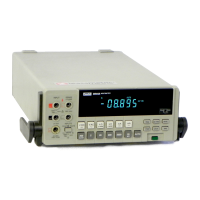Theory of Operation
DC
SCWNG
positive supply is approximately 6.2V above the input and
conversion cycle. The circuit also provides a gain ot 10 in
the negative supply
is
approximately 6.2V below. the 200 mV
dc,
20052, and 2000
mA
dc ranges.,
5-6.
VDC Protection
The circuit operates by cycling between the
track,
stjttling,
hold, and precharge configurations shown in Figurk
5-4.
Input protection for the
M)C
function is provided by a
lK,
me In-Gmd
&
selects a particular settling
and
hold
fusible resistor (R309), four metal-oxide varistors (MOVs)
configuration for each function and range,
and
su
esses
(RV301, RV402, RV403, and RVW), and additional
the pecharge configuration for eatain ranges. Thi$trol
protection resistors and clamp circuits.
is
achieved
by latching function and range informatton in
U301, U302, and U303.
WARNING
TO AVOID INJURY OR
EQUIPMENT
DAMAGE,
USE
EXACT REPLACEMENT
PARTS FOR
ALL
PROTECTION COM-
PONENTS.
I
Basic timing for the
TM
circuit is provided by th%
AD
Converter over clock lines
PC,
HD1, TRl, and TR21 (See
the timing diagram in Figure 5-5, top.) The
T/H
c$cle
is
initiated when the In-Guard
pC
pulls line
TR
low.
5-10. Tmk Configuration
In the track configuration (Figure 5-4A), the
TRI
Frcuit
In
dc
greater
than
fun-
as
a non-inv&ng buffer. The volage on
,008
1560V are clamped by the MOVs. Extreme overvoltage
track
scaled
dc
input
voltage-
conditions cause
R309
to fail open-circuit.
R309
is followed either by a
99
kQ, 10W resistor network
(2304) in the
200
mV, 2V, and 20V ranges, or by 10
MQ
(2302) to ground in the 200V and lOOOV ranges.
2304
provides current limiting in extreme overvoltage condi-
tions in the 200 mV, 2V, and 20V ranges. The non-
5-1
1.
Settling
Configuration
The circuit assumes a settling configuration betwwn the
track and hold configurations. The circuit
assumds
the
configuration &Figure 5-4B for
unity
gain and the cbnfig-
uration in Figure 5-4C for gain of 10.
inverting input of U306 is clamped to +25V by Q307 and
Q308.
5-7.
mA
DC
Scaling
In the
mA
DC
function, the unknown current
causes
a
voltage drop across current shunt R319. This voltage drop
is then measured
as
in the VDC function. The
DC
Scaling
circuit is configured
as
shown by the simplified switch
table in Figure 5-2.
M.
Analog Filter
The
three-pole, low-pass analog filter (U304)
has
a Butter-
worth response with comer frequency at 7
Hz,
giving
approximately 50
dB
of rejection at 50
Hz.
The filter is
used only for the slow reading rate and is used only in the
VDC
ranges
and
lowest three ohms ranges. The filter is
switched into the input signal path by
Q304
(Figure 5-2).
In some ranges and functions, additional filtering is pro-
vided by U302B and
C314.
During this time the
DC
Scaling circuit is still coqected
to the
T/H
amp. However, changes in the input
cib
not
affect the value to
be
measured, which is stored on
(3308.
5-12
Hold
Configuration
The
X1
hold configuration (Figure 54D)
is
used fior
all
VDC
ranges except rl and for all ohms ranges exvt rl.
The output of U307 is the negative of the input vqltage.
The XI0 hold configuration (Figure 5-4E)
is
used fbr the
mA
DC
function, the 200 mV dc range, and the
b0052
range, and provides a gain of 10.
5-13. Pre-Charge Configuration
The pre-charge configuration (Figure
5-4F)
occurs
I
after
the hold configuration in VDC ranges rl, r2, and r4, and
ohms ranges 11, r2, r3, and r4. U306 is connectd,
as
a
buffer to charge stray capacitance at the non-inverting
input of the
T/H
Amplifier. The pre-charge configuration
is not used in any other ranges.
5-9.
TRACWHOLD CIRCUIT 5-14. PRECISION
VOLTAGE
REFERENCE
The TracWold
(Tm)
circuit presents
a
stable voltage to
The Precision Voltage Reference (Figure 5-6) pqvides
the
A/D
Converter during the input
period
of the
AID
precise reference voltages of -7.00000 and +7.0000C4. The
5-4
Artisan Technology Group - Quality Instrumentation ... Guaranteed | (888) 88-SOURCE | www.artisantg.com

